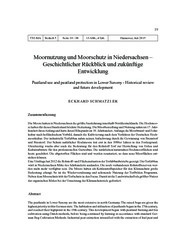Moornutzung und Moorschutz in Niedersachsen – Geschichtlicher Rückblick und zukünftige Entwicklung
Schmatzler, Eckhard
Beiheft 5: 19 - 38
Schmatzler, Eckhard, 2015: Moornutzung und Moorschutz in Niedersachsen – Geschichtlicher Rückblick und zukünftige Entwicklung. In: TELMA - Berichte der Deutschen Gesellschaft für Moor- und Torfkunde, Band Beiheft 5: 19 - 38, DOI: 10.23689/fidgeo-2925.
 |
Dokument öffnen: |
Abstract: The peatlands in Lower Saxony are the most extensive in north Germany. The raised bogs are given the highest priority in this German state. The habitation and utilisation of peatlands began in the 17th century, and reached their highpoint in the 19th century. This development began with peatland burning and fen cultivation using Dutch methods, before being continued by farming in accordance with standard German Bog Cultivation Methods. Industrial peat extraction intensified with the extraction of fuel peat and animal bedding peat. The protection of natural raised bogs first became a priority in the 1980s. This happened simultaneously with an increase on the importance of peat as a natural resource for professional horticultural soils and potting composts. Natural and close-to-natural raised bogs enjoy protection today. The areas from which peat was extracted are in the process of being renaturised to enable the creation of new peatlands. A survey revealed the raw material and land areas of the peat extraction industry in 2012. Peat extraction in Lower Saxony will come to an end in the middle of the century. The remaining reserves of peat raw material will no longer be available for extraction. The peatlands are of major significance for climate protection because of their capacity to store carbon. This is why there is a strategic programme for the rewetting and conservational utilisation of peat soils. In addition to peatland protection, the focus now also includes peat protection. As the largest users of organic soils, the agricultural sector must therefore play its part in achieving the climate protection objectives. Zusammenfassung:
Die Moore hatten in Niedersachsen die größte Ausdehnung innerhalb Norddeutschlands. Die Hochmoore haben für dieses Bundesland höchste Bedeutung. Die Moorbesiedlung und Nutzung nahm im 17. Jahrhundert ihren Anfang und hatte ihren Höhepunkt im 19. Jahrhundert. Anfangs die Moorbrand- und Fehnkultur nach holländischem Vorbild, danach die Kultivierung nach dem Verfahren der Deutschen Hochmoorkultur. Der industrielle Torfabbau nahm seinen Aufschwung durch die Gewinnung von Brenntorf und Streutorf. Der Schutz natürlicher Hochmoore trat erst in den 1980er Jahren in den Fordergrund. Gleichzeitig wuchs aber auch die Bedeutung für den Rohstoff Torf zur Herstellung von Erden und Kultursubstrate für den professionellen Gartenbau. Die natürlichen/naturnahen Hochmoorflächen sind heute geschützt. Die abgetorften Flächen sind und werden renaturiert, so dass neue Moorflächen entstehen können. Eine Umfrage hat 2012 die Rohstoff- und Flächensituation der Torfabbaubetriebe gezeigt. Der Torfabbau wird in Niedersachsen Mitte des Jahrhunderts auslaufen. Die noch vorhandenen Rohstoffreserven werden nicht mehr verfügbar sein. Die Moore haben als Kohlenstoffspeicher für den Klimaschutz große Bedeutung erlangt. So ist die Wiedervernässung und schonende Nutzung der Torfböden Programm. Neben dem Moorschutz tritt der Torfschutz in den Focus. Damit ist die Landwirtschaft als größter Nutzer der organischen Böden bei der Umsetzung der Klimaschutzziele gefordert.
Statistik:
ZugriffsstatistikSchlagworte:
Moorpeatland
mire
land-use
Torfabbau
peat mining
Torf
peat
Geschichte
Wiedervernässung
Niedersachsen

